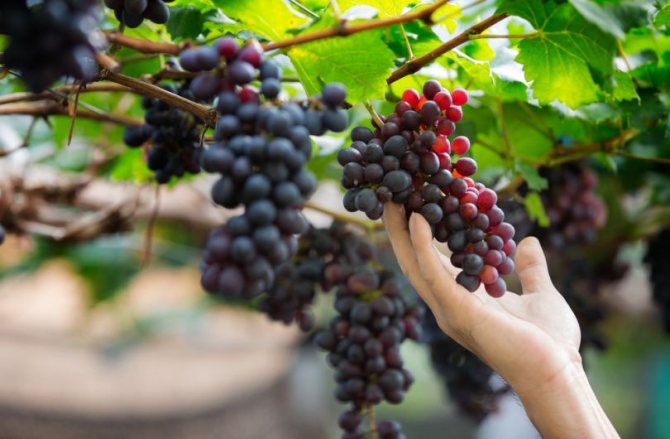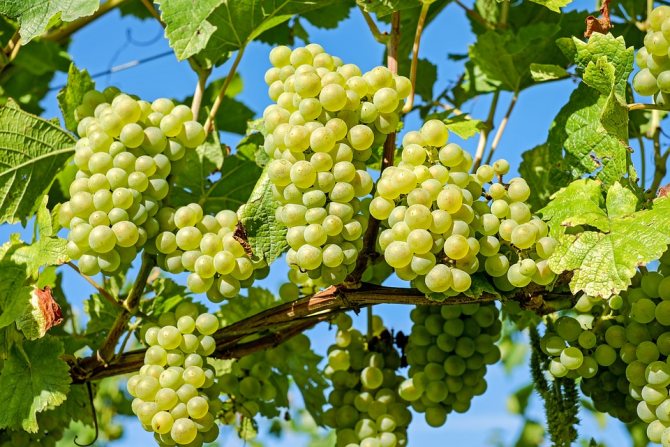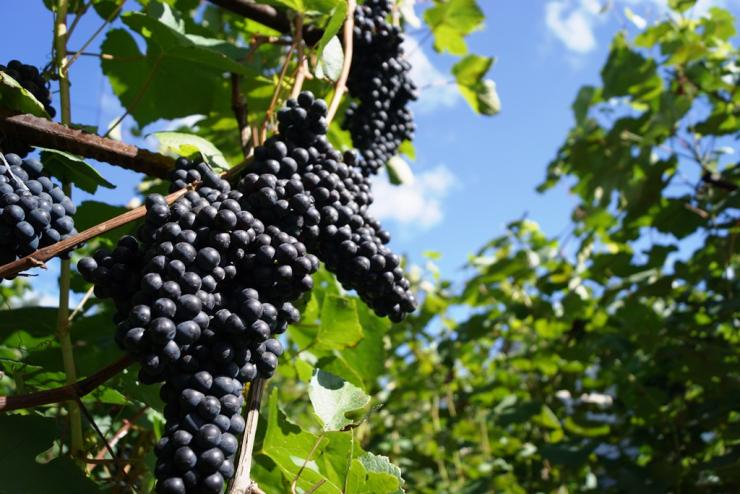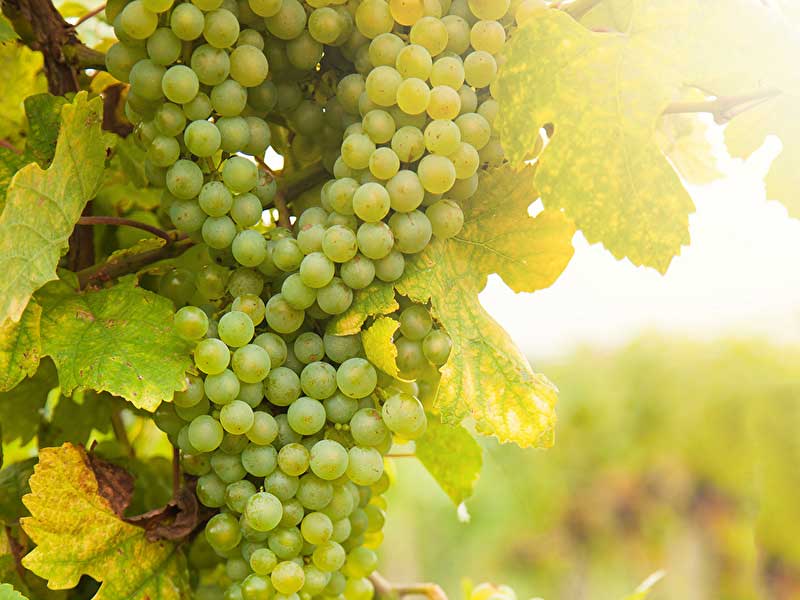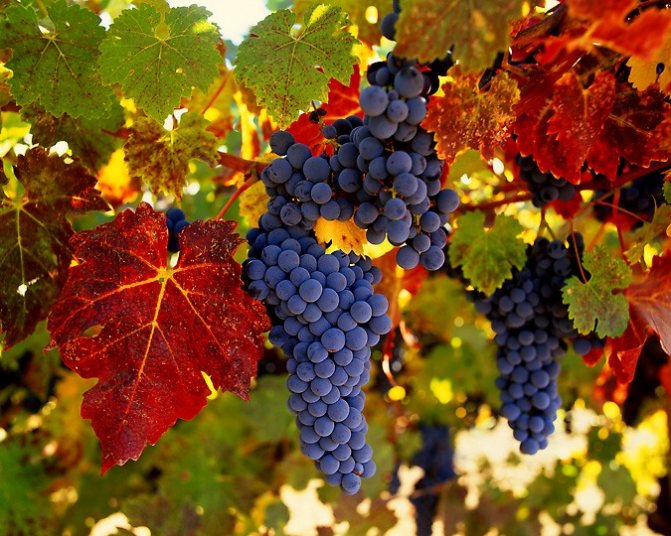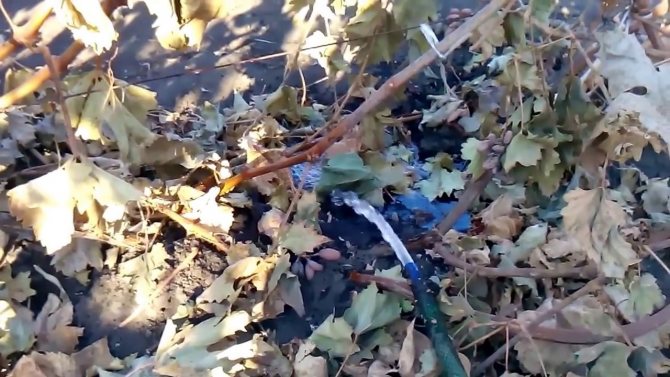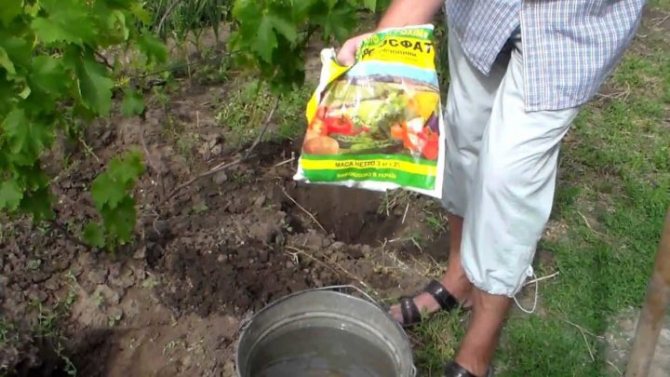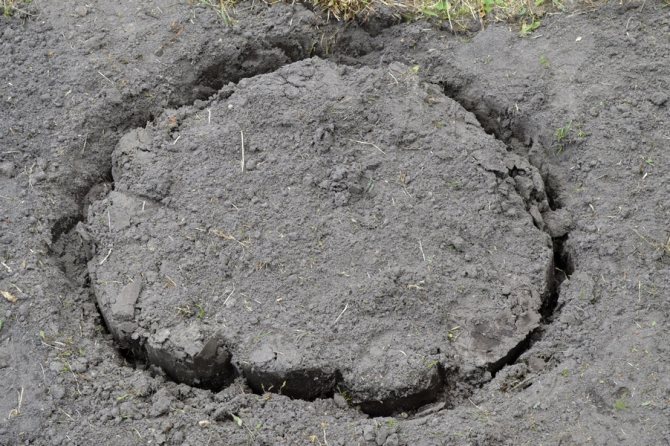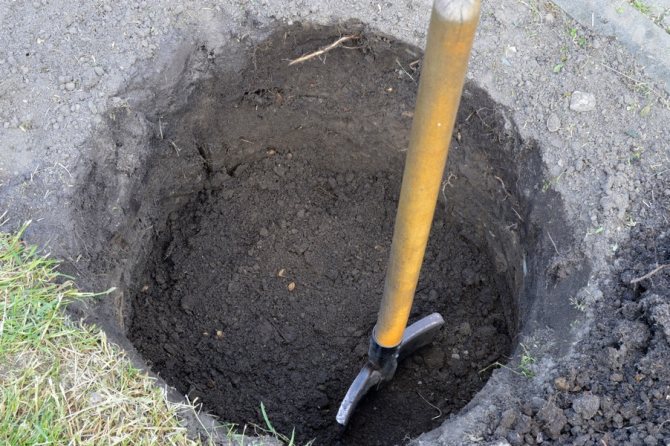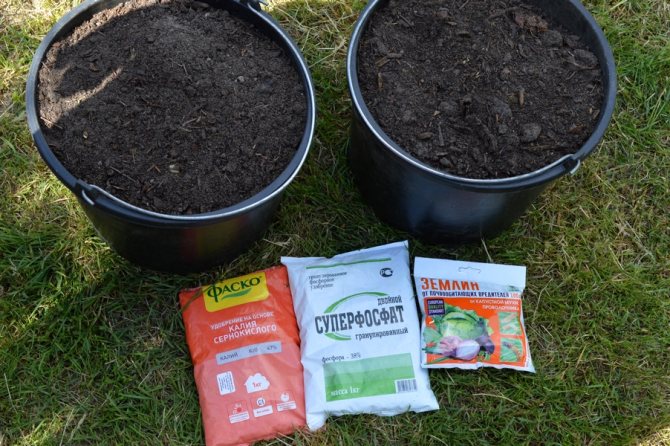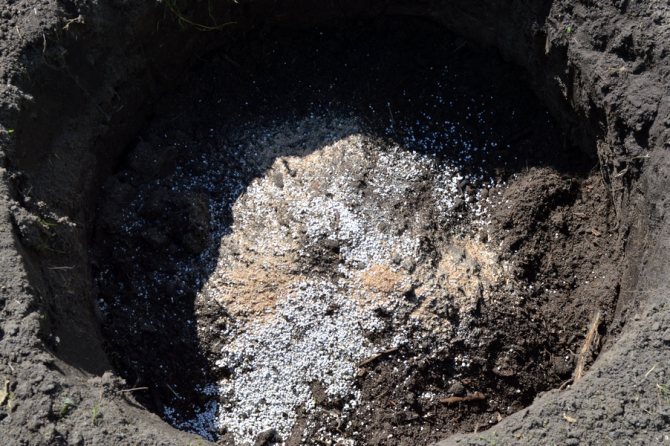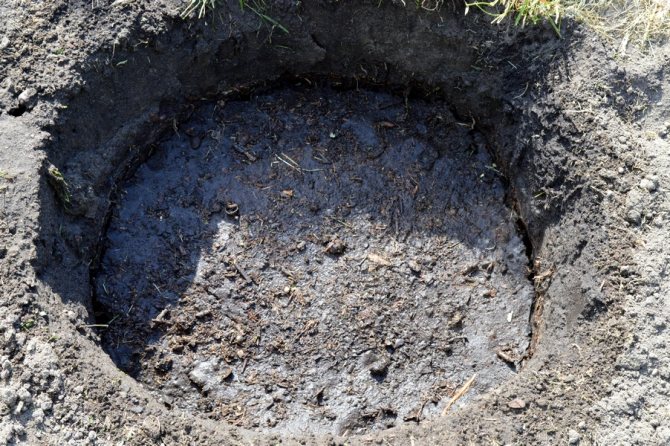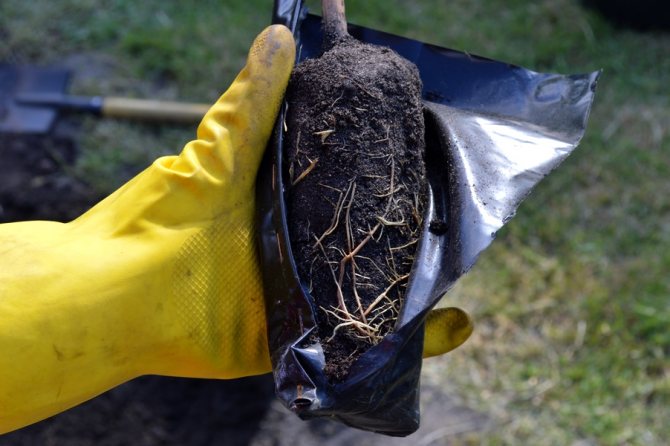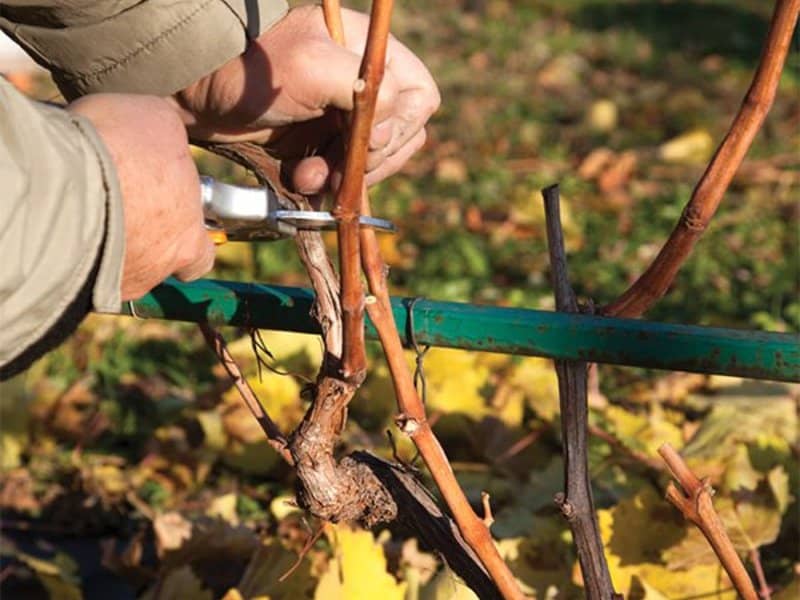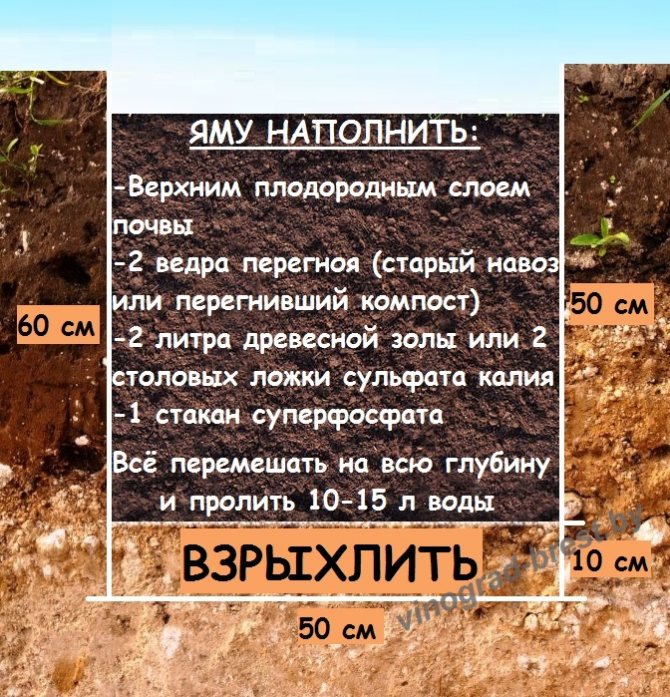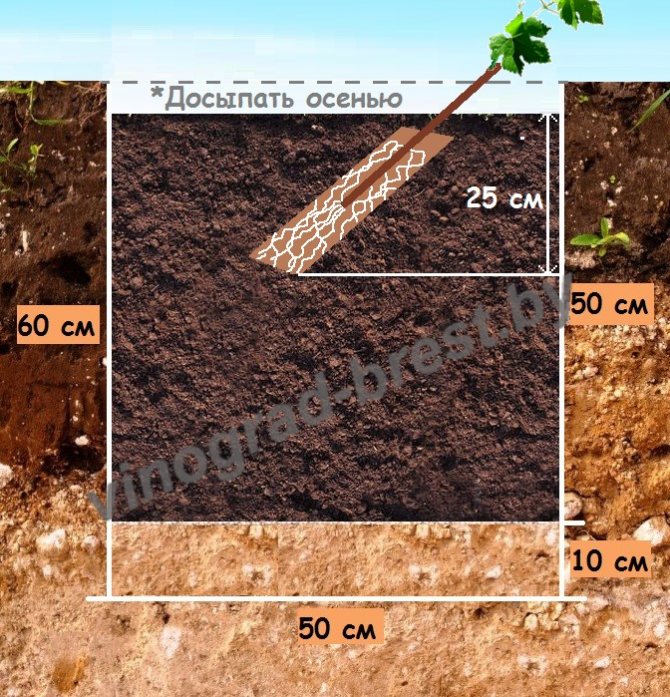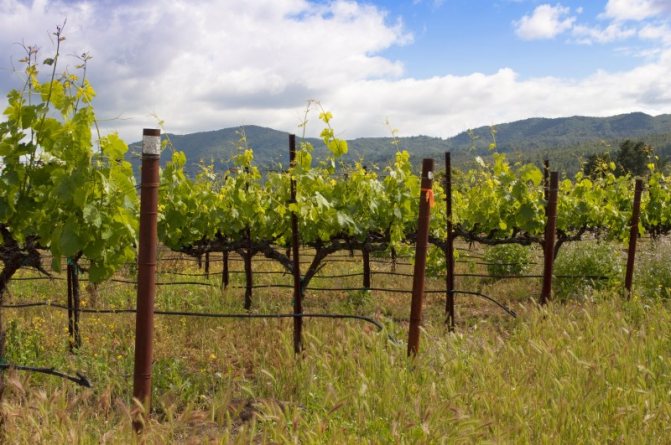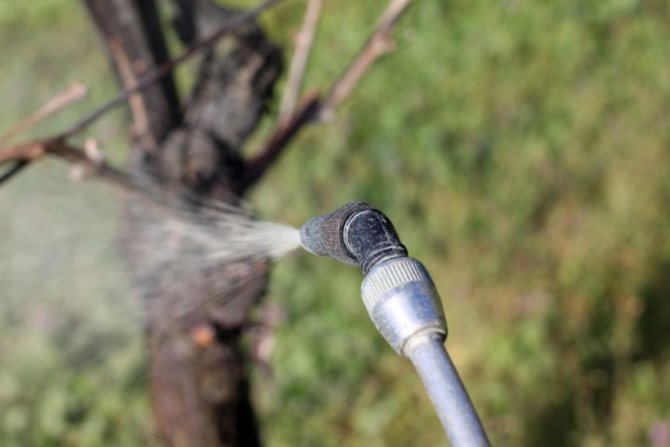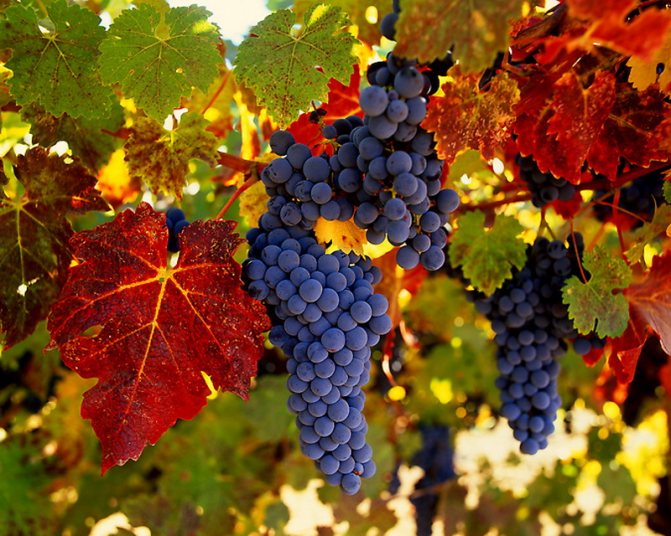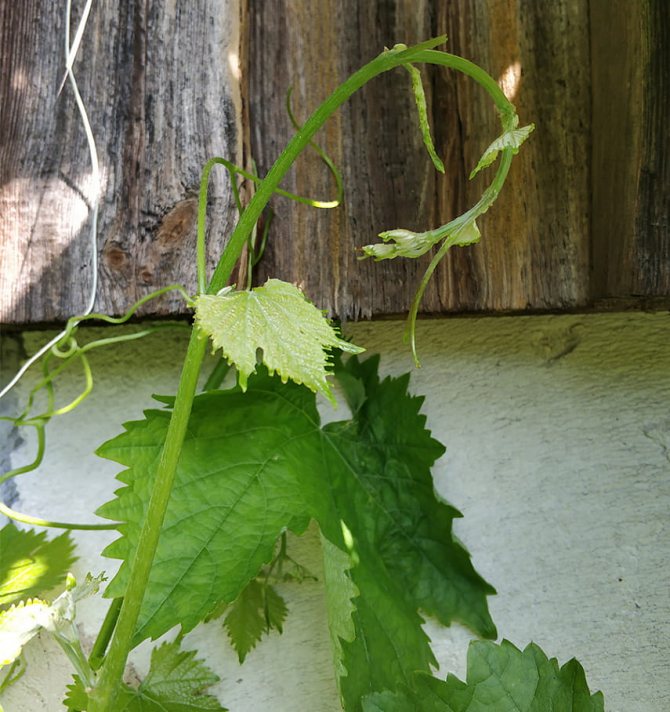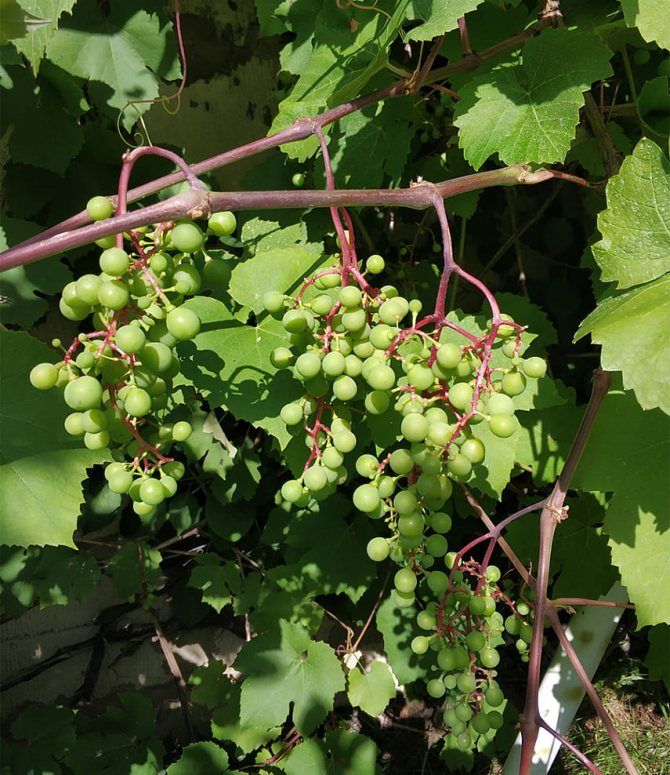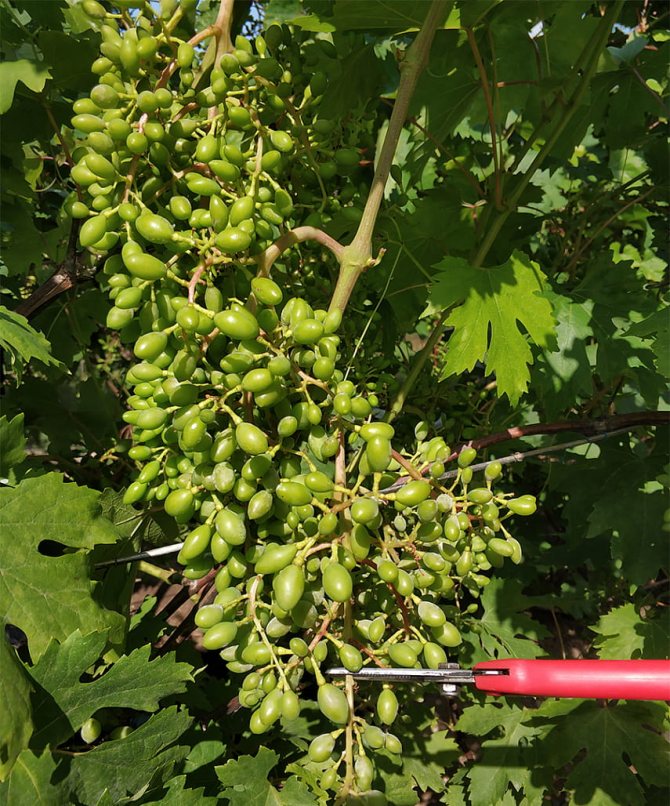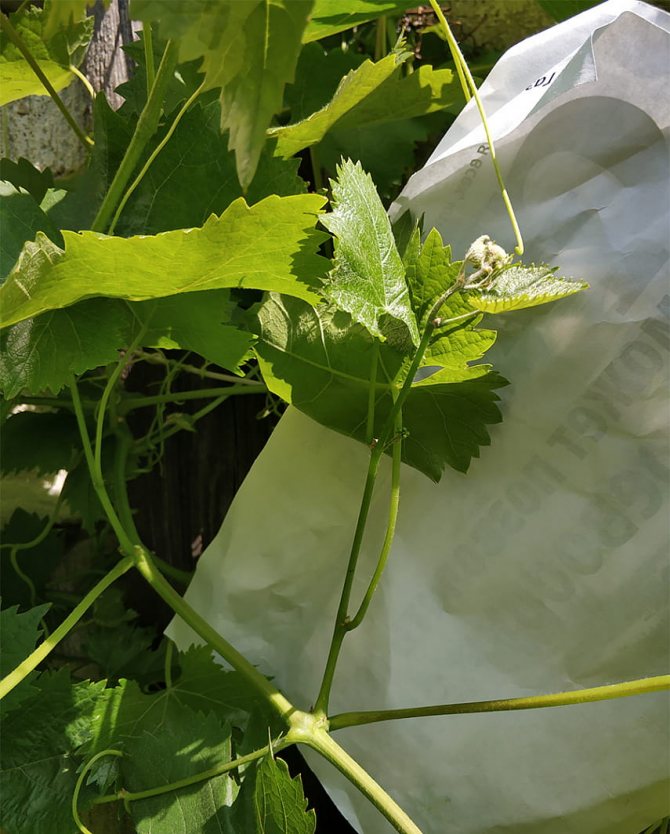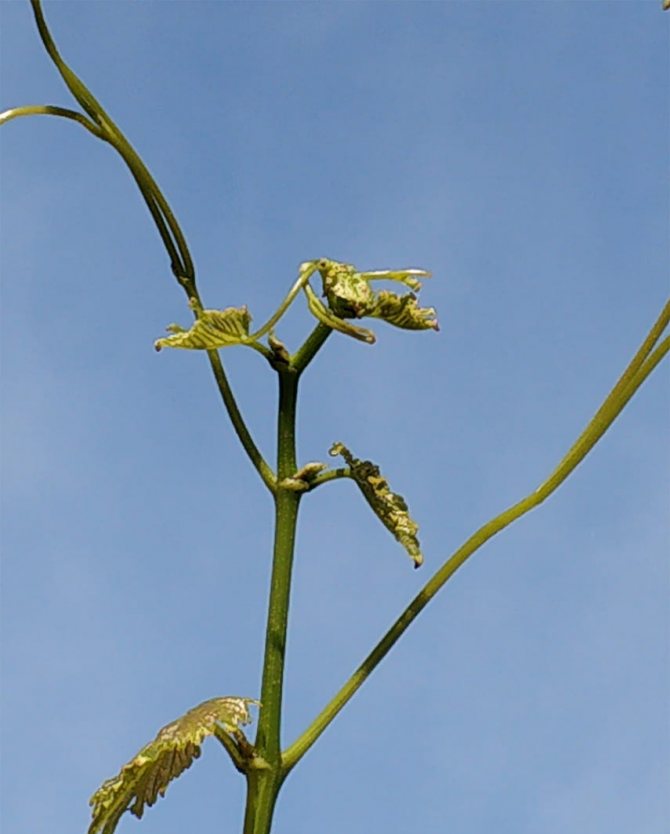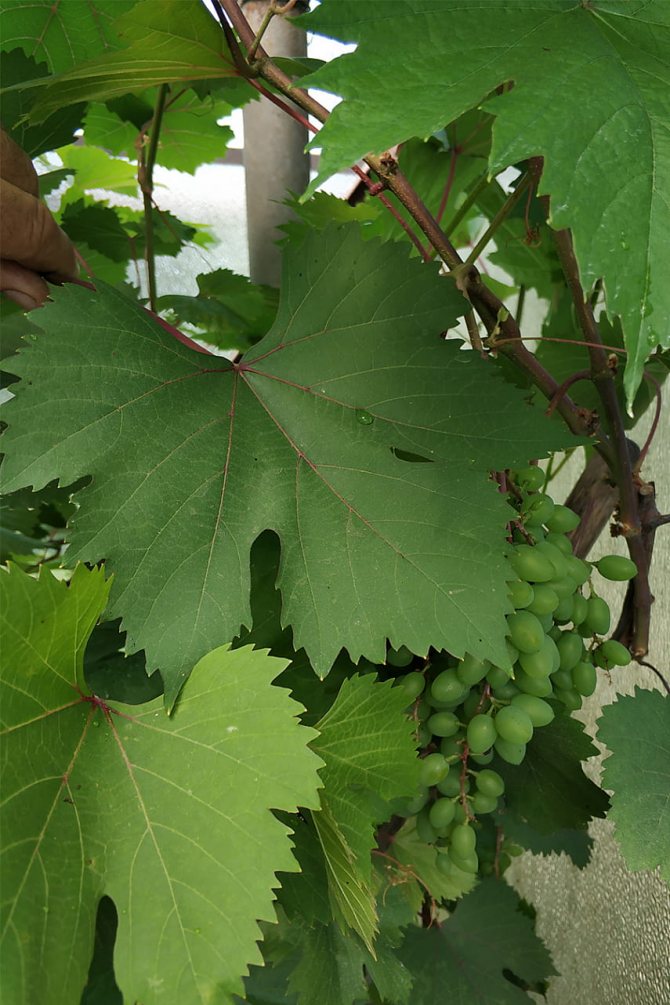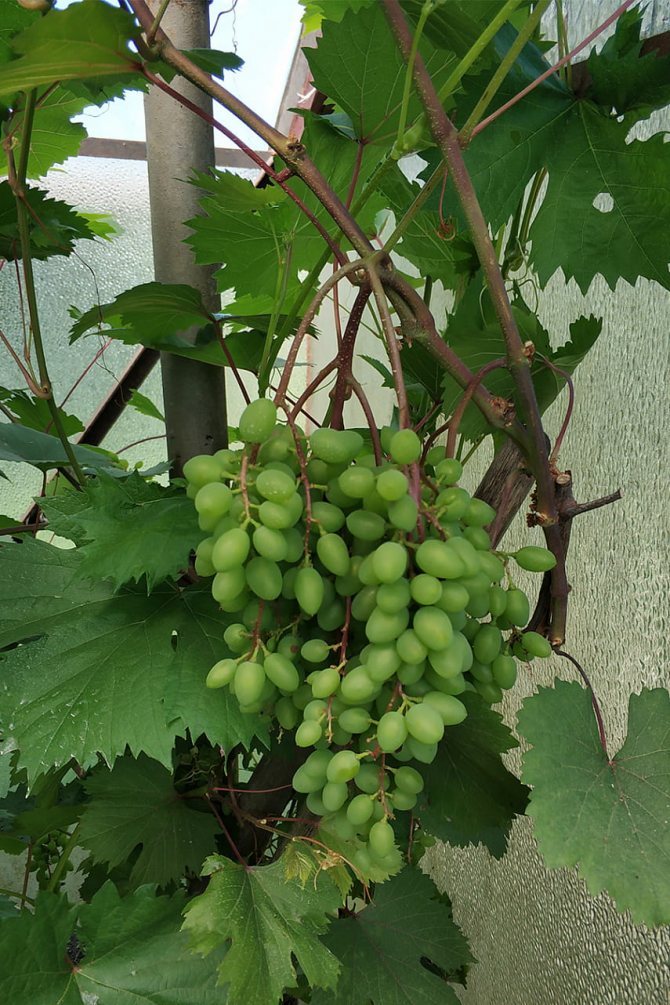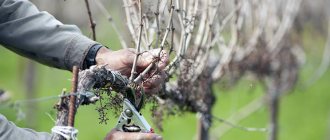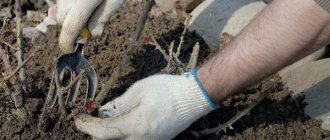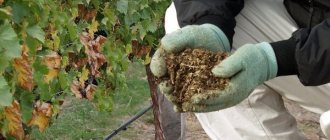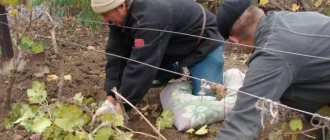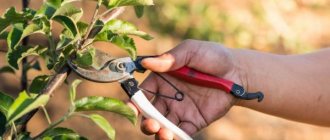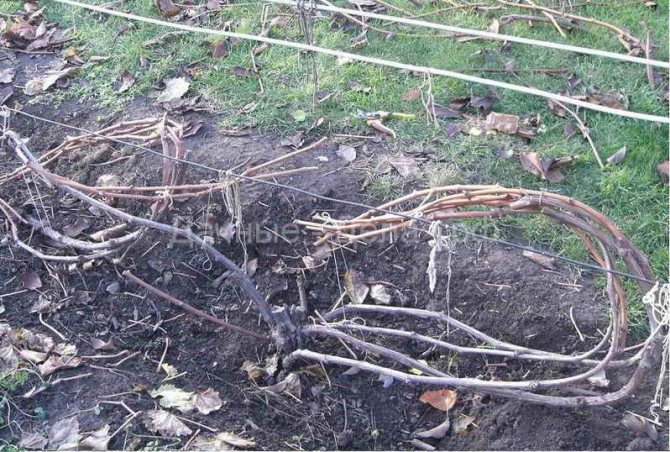
Vineyard care in the fall includes measures to ensure high yields of late ripening varieties and prepare for the coming winter. If the fall is delayed, it is better to sacrifice part of the harvest and relieve the vine. Work with grapes in the fall includes tying and pruning branches, feeding the bushes with fertilizers, spraying with effective preparations to ensure better fruit formation for the next year.
Content
- Description
- Planting grapes When to plant in autumn
- Seedling care
- How to plant
- Watering
- When to trim
- Preparing for winter
Treatment
Spraying grapes to protect against disease is necessary throughout the season.
In the spring, before bud break, the bushes are treated with a 3% solution of copper sulfate or Bordeaux liquid. The second spring spraying is carried out after the formation of 5 leaves. To do this, take a reliable fungicide, for example Nitrafen, diluted in an amount of 300 g in 10 liters of water.
Attention! The last spring spraying must be completed 2 weeks before the plant enters the flowering phase.
Summer treatment protects against the development of dangerous diseases of mildew, oidium and gray mold. Fungicides such as Topaz, Quadris, Strobi are suitable for this. You need to perform the procedures with an interval of 3 weeks.
The last autumn treatment with a 3% solution of copper sulfate or Bordeaux mixture will not only destroy pathogenic bacteria and fungal spores, but also saturate the soil with iron.
Grapes - description
Cultural grapes in favorable conditions can reach a length of 30-40 meters, in cooler regions - no more than three meters. Liana is attached to the support with antennae. The bark on young vines is reddish or yellowish, on adult trunks it is brown, with deep grooves, flaking. Leaves are petiolate, alternate, whole, three-five-lobed. The flowers are small, greenish, bisexual, gathered in a panicle, bloom in May or June.
Fruiting begins in August or September, and the late varieties ripen in October. Juicy grapes with seeds in an amount of one to four, and some varieties without seeds at all - green, yellow, black-purple or dark red - are collected in clusters of various shapes and sizes. Before phylloxera appeared in Europe in 1963, cultivated grapes lived up to 150 years.
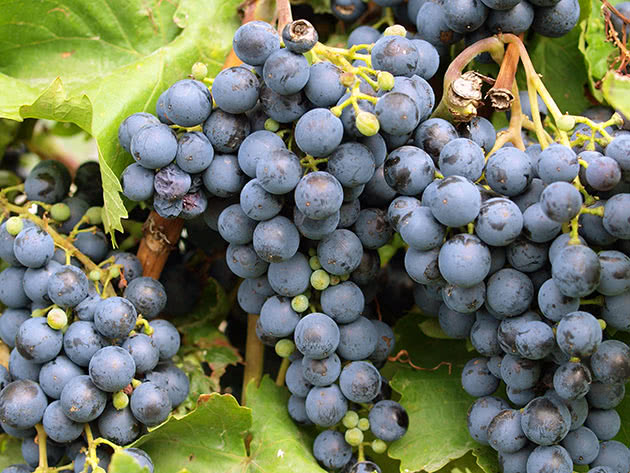

Which grape variety should you choose?
When choosing a variety of any cultivated plant, it is necessary to be guided by its adaptability to the climatic zone where you plan to grow it. And grapes are no exception. therefore, preference should be given to the most frost-resistant varieties.
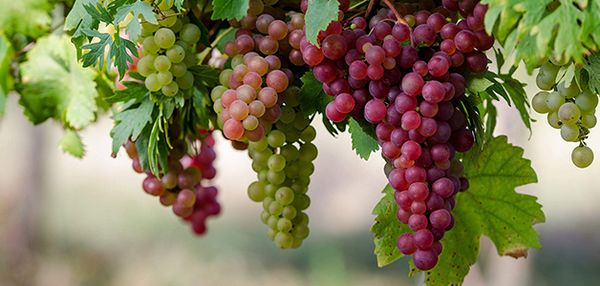

Isabella, Madeleine Angevin, Chassela white are very popular in the northern regions. If you are a beginner gardener, then choose a variety that is resistant to winter cold and various diseases. Most of all grapes are susceptible to the pathogenic effects of the fungus.These varieties include non-covering varieties, it is many times easier to grow them, but they will also be slightly inferior in taste.
Great for beginners:
- Delight.
- Russian Concorde.
- Lydia.
- Dniester pink.
This is not a complete list, because only Belarusian breeders were able to breed more than two hundred varieties of frost-resistant grapes. Therefore, when buying seedlings, pay attention to the characteristics.
A very important indicator, in addition to resistance to cold, is the ripening period. The shorter it is, the better. Indeed, from the moment the bud opens up to the appearance of a ripe berry, the sun's rays should generously endow the plant. Otherwise, the taste of the resulting crop will leave much to be desired. And it is also important that the temperature during this period should not fall below 15 C.
Planting grapes in autumn
When to plant grapes in autumn
Planting grapes in autumn with seedlings begins in the first weeks of October and ends with the onset of cold weather. The latest date is 8-10 days before the onset of the first frost. The justification for preference for autumn planting over spring planting is that at this time the buds are still asleep, and the root system is already developing, which is why the activity of young shoots begins in early spring of next year. Plus, if you've just bought a seedling, it won't need to be stored until spring.
- Bird cherry: planting and care in the open field, properties
Grapes are photophilous, therefore, when choosing a place for it for many years, try to find an open area, protected from cold winds and drafts. It is not recommended to plant grapes near large trees, which will not only block it from the sun, but also prevent it from fully developing, sucking nutrients from the soil with its roots.
Grape seedlings in autumn
It is advisable to purchase seedlings from well-established sellers in the market, but this is not the only warning. A high-quality seedling with an annual green shoot 40-50 cm high with a trunk thickness of 7-8 mm should have at least three light brown roots 10-15 cm long and at least 2-3 mm thick. The shoot should have well-ripened buds, and the roots should not be dry. Before planting, the shoots of the seedlings are shortened to 3-4 eyes, the roots are cut off at the upper nodes, and the remaining ones are slightly trimmed and placed in a heteroauxin solution for 12 hours.
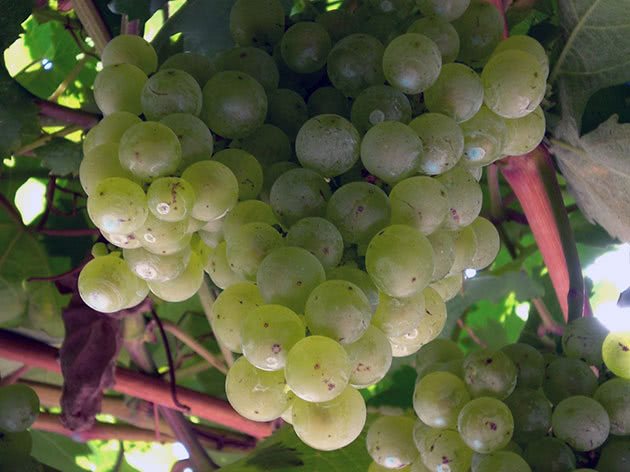

How to plant grapes in autumn
Pits for grapes are dug in advance with a size of 50x50x60, a drainage layer of crushed stone or broken brick 5-7 cm thick is poured into them, thick paper is laid on top, a drainage pipe is installed under the wall of the pit, through which the bush is subsequently fed and watered. Then a couple of buckets of fertile soil, a glass of nitroammofoska, a handful of ash, a bucket of humus are poured into the pit, everything is thoroughly mixed and then the pit is filled to the top with earth. Fill only the upper, fertile layer of earth into the hole; it is better not to use the lower layer.
Now you need to water the hole abundantly several times, and you will see that the soil will settle in it. Let the pit stand for a couple of weeks after precipitation. It is impossible to plant grapes at once, because, settling, the earth will tighten the seedling deeper and tear its roots. It is best to start preparing the pit for the autumn planting of grapes in early August. If you are planting several seedlings, the distance between the holes should be at least one meter.
During planting, a bucket of earth is poured into the center of the pit, a seedling is placed on it, the roots are straightened and the hole is covered with fertile soil until it grows. Short seedlings are placed vertically on a mound, and those that are higher than 25 cm are placed in the hole obliquely - the main thing is that the heel is at a depth of 50 cm, and the base of the growth at a depth of 25 cm.After filling the hole, compact the soil and water the seedling liberally with two to three buckets of water, then cover it with a cut plastic bottle.
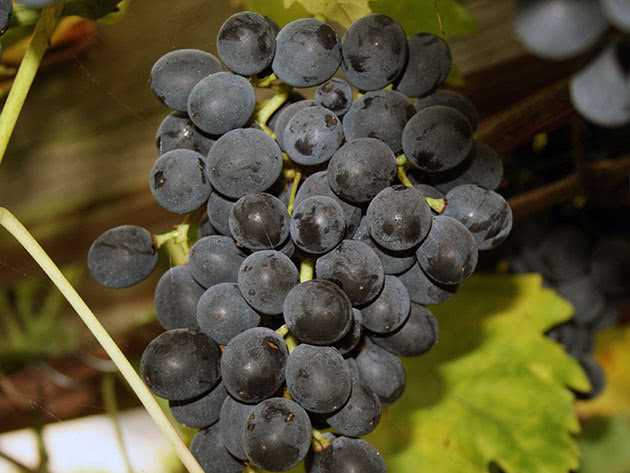

Autumn fertilization of vines and tillage
Top dressing is an important factor in a high-quality harvest for the next year. It will nourish the vine and roots, provide a comfortable wintering and the laying of future buds.
As complementary foods in the autumn, you can use:
- compost (at least two years old) right under the root;
- humus is also at the root or in the dug earth;
- dry wood ash and lime directly into the ground.
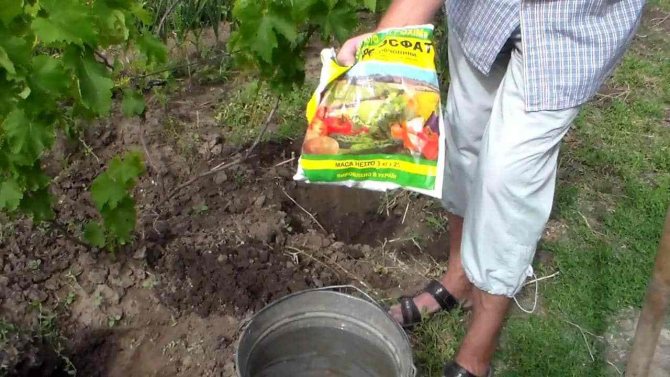

In addition to organic matter, grapes also need mineral fertilizers.
Once every 3-4 years, grape crops require potassium-phosphorus feeding. Usually it is a mixture of superphosphate and potassium salt or potassium sulfate. Complementary food can be applied directly to the ground, while digging, or diluted with water and watered directly under the roots. For 1 sq. meter needs 25 g of superphosphate and potassium.
In the middle of autumn, it is necessary to dig up the ground around the bush up to 30 cm deep. During digging, you can immediately add lime and wood ash to the ground.
It's important to know! For surface watering, it is recommended to loosen the soil constantly.
Grape care in autumn
Watering grapes in autumn
How to care for grapes in the fall? If the weather is not too hot, then the grapes are not watered after harvest. In order to prepare the roots of the grapes for wintering, one plentiful sub-winter watering in October will be enough. If during planting you did not dig a pipe for irrigation and feeding into the hole, make shallow grooves around the bushes so that the water does not spread during watering, but goes deep into the very place where the roots of the grapes are located. Periodic loosening of the soil is imperative to avoid rapid evaporation of moisture and soil compaction.
Transplanting grapes in autumn
It is also better to replant grapes in the fall, after the leaves fall, but before the first frost. The main task is not to damage the fragile rhizome of the plant in the process. You already know how to cook a pit for grapes. Young three-year-old bushes are transplanted together with an earthen lump, without shortening the rhizomes, and so that the soil does not crumble, the bush is not watered for several days.
Five to seven-year-old bushes are dug in from all sides (radius of about 50 cm) as deep as possible, but it is unlikely that it will be possible to get the whole root, since sometimes the grapes go into the ground by one and a half meters. Remove the bush, very carefully free the roots from the ground, remove the old parts of the rhizome. Cut off excess vines, leaving no more than two sleeves with one or two vines each. Shorten the tops of the branches slightly. Seal the sections with wax. Dip the rhizome in a clay mash with the addition of potassium permanganate and lower it obliquely into the hole. Then proceed as described in the section on planting grapes.
When to replant grapes in the fall so that they have time to take root in a new place? Yes, at the same time as the initial landing.
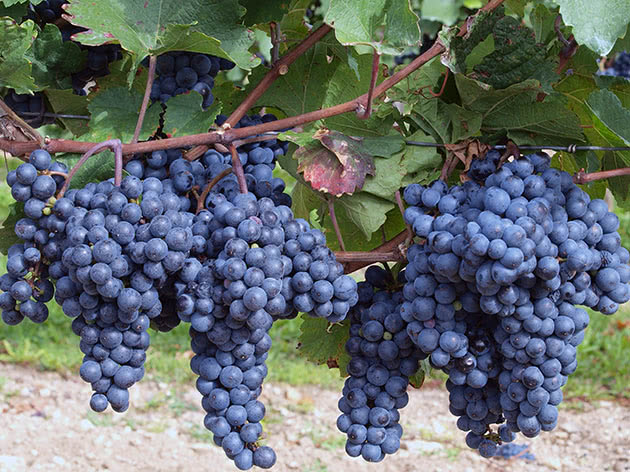

Top dressing of grapes in autumn
After harvest, the grape bushes are weakened, and in order to prepare them for winter, fertilization must be applied to the soil. Fertilization of grapes in the fall is applied once every three to four years, and it is best to use organic matter for this purpose, for example, in the form of mulch around a bush from rotted manure or peat with the addition of ash. However, in feeding the grapes, it is necessary to show a sense of proportion, since this is exactly the case when it is better to underfeed the plant than to overfeed.
Grape processing in autumn
As soon as the crop is harvested, it is necessary to treat the vineyard from various kinds of infections of both plant and animal nature, since it will be much more difficult to get rid of them in the spring. There are no berries on the bushes anymore, and strong drugs can be used.
Usually, the processing of grapes is combined with a shelter for the winter - the trimmed shoots are tied, treated with a five to seven percent solution of ferrous sulfate (500-700 g of the drug per 10 liters of water). This spraying will kill the infection on the surface of the vine, but pests and diseases of the grapes such as mites and powdery mildew will not be particularly affected - to combat these problems, there is Tiovit or colloidal sulfur. If you find a grape leafworm on grapes, use Rovikurt against it, and you should fight against cercospora with Fundazole or Polychom.
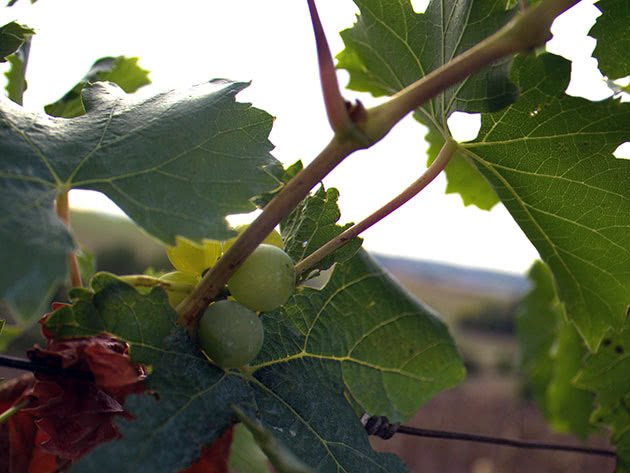

Reproduction of grapes in autumn
The easiest way to propagate grapes is cuttings, or shanks. During autumn pruning, you can prepare cuttings and put them in storage in order to plant them in a school in spring. Or you can try to root them at home in winter. But first you need to cut the cuttings from the matured vine: the thickness of such a vine should be at least 7 mm, it is dark or light brown in color, hard and crackling when bent.
- Bird cherry: planting and care in the open field, properties
Cuttings from green vines are not suitable. Choose an already fruiting vine, on which the "tails" from the bunches have been preserved, check that there are no mechanical damage and signs of disease with powdery mildew, mildew or phylloxera. Cuttings 30-40 cm long are cut from such a vine, on which there should be at least three buds. The most important task is to keep moisture in the shanks, otherwise they will never take root. Therefore, you need to cut it so that on both sides the shank ends with a mustache or a "tail" from the bunch - the membrane in these internodes will protect the cutting from moisture loss.
The cut cuttings are placed in water for 6-8 hours, then, after drying, they are treated with a "phytodoctor" and, having provided with a tag with the name of the variety, are tied into bunches. Store cuttings in a humid environment at temperatures between 0 ºC and 5 ºC - in the ground, in a basement or refrigerator, which is much easier. To do this, wrap the cuttings in a damp cotton cloth and place in a perforated plastic bag to allow air to flow. Check the fabric from time to time for moisture, and soak it if dry.
In the spring, the seedlings are rooted.
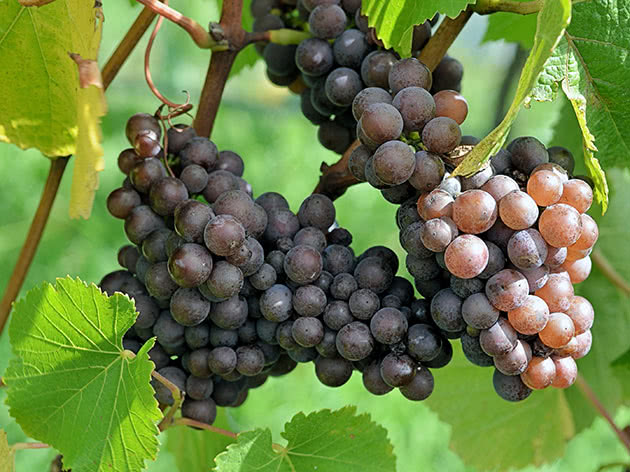

Shelter for the winter
Despite the fact that most varieties can withstand temperatures of -15 ... -24⁰С, warming grapes in autumn is another mandatory procedure. In the middle lane and more northern regions, it is desirable to carry out it for any grape variety. In southern regions with a mild climate, it is also better to cover bushes, but an exception can be made for winter-hardy varieties.
Covering the bushes too early is not recommended, as they can start to rot on sunny days. It is also not worth tightening, so as not to get frozen roots and fragile, brittle vine. The optimal period when the average daily temperature is set at around -5 ⁰С.
Many different materials are used for covering:
- polyethylene film;
- agrofiber;
- sawdust;
- straw;
- fallen leaves;
- spruce branches;
- cardboard;
- roofing material;
- wooden shields;
- snow;
- land.
More often than not, experienced growers combine several materials to achieve maximum effect.
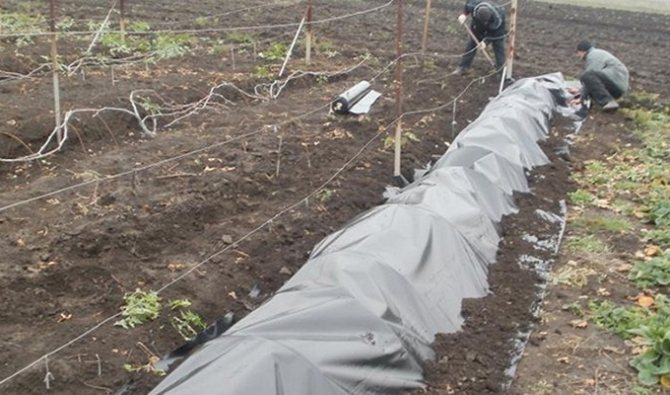

Shelter
One of the most common ways is to hide the vine in a trench. To do this, a ditch is dug about 35 cm deep, a rolled vine is laid in it, which is covered with a layer of sawdust or straw on top. Next, a layer of earth is poured and, finally, the entire structure is covered with a film that will protect the structure from moisture penetration.
Another option is to protect the bushes without removing them from the trellises. To do this, a thick layer of earth is raked to the bottom (it serves to protect the roots), and then the embankment and the bushes themselves are covered with spruce branches on all sides. After a snowfall, the structure is insulated by throwing a layer of snow onto the spruce branches.
Autumn grape pruning for beginners
When to prune grapes
Pruning grape bushes not only makes it easier to care for the plant and picking berries, but also allows you to get a rich harvest.And a direct relationship was found between the pruning of grapes and the number of berries harvested from a curious event: many centuries ago, winegrowers who supplied their product to the troops of the Roman Empire noticed that those bushes that a donkey had eaten last year grow better and bear fruit more abundantly. Since then, they began to carry out annual pruning, especially since it has a positive effect not only on the number of berries harvested, but also on their size and taste.
Autumn is the best time for the formation of grape bushes, especially if you are growing varieties that need to be covered for the winter, and you need to start the pruning procedure two to three weeks after all the leaves have fallen from the grape bushes. Pruning earlier becomes the reason that the root system and vines of the plant do not have time to receive the necessary amount of nutrients necessary for the grapes to survive the winter, and too late pruning of grapes for the winter can cause injury and damage, since grapes the whips become brittle. However, preliminary pruning should be done in September.
Spring pruning of grapes at the beginning of sap flow is not encouraged because the vine, on which the wounds always heal for a very long time, begins to "cry", that is, to drain juice, and as a result, you not only will not wait for a good harvest, but may even destroy the plant.
How to prune grapes in the fall (pruning scheme)
For those who do not yet know how to properly prune grapes in the fall, we offer a simplified pruning scheme. Pruning grapes in the fall for beginners is carried out in two stages.
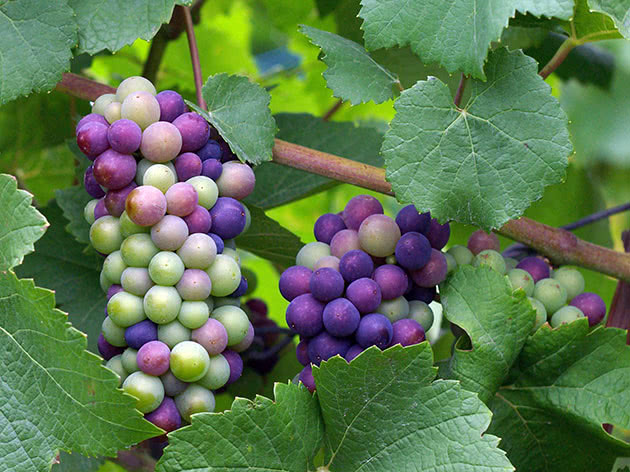

First stage. Before pruning grapes for the winter in October, at the beginning of September, preparations are made for the autumn formative pruning. Unnecessary green growths should be removed on each perennial shoot below the first wire, stretched at a height of half a meter from the ground. On those increments that appeared on the sleeves above the lower wire, minting is carried out, that is, 10-15% of the entire length of the increment is cut off. Lateral shoots on growths are shortened to 2-3 leaves. This completes the first preparatory stage.
Second phase. Two to three weeks after the leaf fall, a fruit link is formed, which should consist of a replacement knot and a fruit arrow. Pruning begins with more frost-resistant varieties - with Isabella, December, Gift or Lydia. Varieties with low cold resistance are cut last.
Select two developed shoots at the height of the two lower wires of the trellis, the lower of which should be on the outside of the sleeve growing at an angle. This shoot is cut under the replacement knot, leaving no more than three eyes on it from the base. The next shoot, growing above and on the side of the sleeve opposite from the replacement knot, is cut under the fruit arrow, leaving on it:
- five eyes, if the diameter of the shoot is 5 mm;
- six eyes, if the diameter is 6 mm;
- seven to eight eyes with a shoot diameter of 7 mm;
- eight to nine eyes with a diameter of 8 mm;
- nine to eleven eyes with a diameter of 9 mm;
- eleven to thirteen eyes with a shoot diameter of 10 mm;
- twelve to fourteen with a diameter of 11 mm;
- thirteen to fifteen with a diameter of 12 mm.
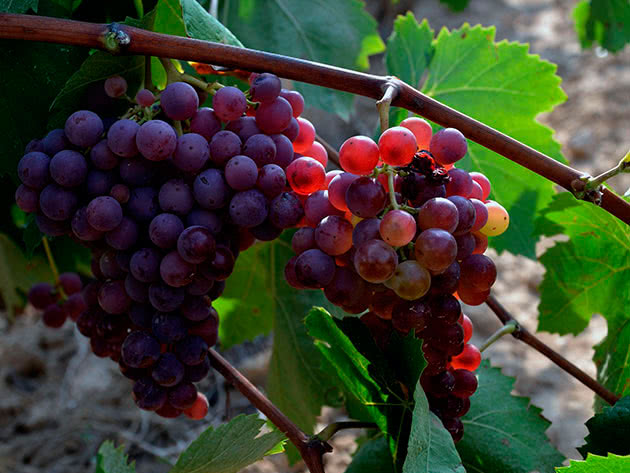

If your grape variety gives bunches weighing more than half a kilogram, then leave the minimum number of eyes from those indicated in the list on the fruit arrow, and if the bunches are lighter than 500 g, then leave the maximum number of eyes. For example, if a bunch of your grapes weighs on average a pound or more, then with a shoot thickness of 12 mm, leave 13 eyes on the fruit arrow, and if the bunch weighs less than 500 g, then leave 15 eyes.
Pruning grapes in the Moscow region
In the Moscow region, attempts to grow grapes were made back in the 17th century, at present, thanks to the work of breeders, a huge number of varieties of cultivated grapes have been bred, which, with good shelter for the winter, give excellent yields. Moreover, these varieties in the Moscow region practically do not need treatment for diseases.
Among these varieties, the most popular are Cardinal, Arcadia, Kodryanka, Delight, Timur, Kuban, Izuminka and others. As for the principles and timing of pruning in the Moscow region, they are no different from the same procedure and time limits for grapes grown somewhere in the south of Ukraine or in the Crimea. But to cover the grapes for the winter will have to be more thorough.
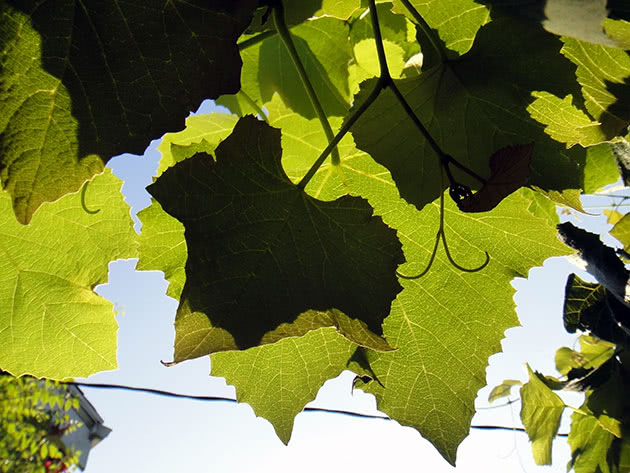

Pruning grapes in Siberia
Pruning grapes in Siberia is done only in autumn, because if you cover uncut grapes for the winter, in spring, when the temperature rises to 5 ºC under cover, the unripe vines will start to rot, and after removing the protection from the cold, you will see an unsightly picture: most of the sleeves and vines covered with gray mold, or green from rotted buds. We have to start growing grapes from the very beginning.
- Bird cherry: planting and care in the open field, properties
In addition, after pruning, a grape bush takes up two to three times less space than an uncut one, it is easier to remove it from the support and cover it for the winter. For these reasons, the main task of the gardener in the fall is to accelerate the process of maturation of the wood of young vines, which do not ripen naturally before the onset of frost in Siberia. To this end, in the second half of September, the base of the grape bush is cleared and thinning pruning is carried out, after which the sun's rays gain access to each vine - they remove all the greens, which probably will not have time to woody before winter, cut off the antennae, crooked shoots, all the remaining stepchildren.
You need to start clearing the bush from above, gradually moving down. They do not pre-prune the plants of the first and second years of life: for the seedlings planted in the current year, only the top is cut off, and for last year's seedlings, only stepsons and tops are removed. The final autumn pruning is carried out after the first strong frost, during which the grape foliage will freeze. After the death of the leaves, food stops moving from the shoots to the roots, so there is no point in pulling with pruning.
The final pruning, in contrast to the preliminary one, starts from the bottom of the bush and is carried out as already described - forming a fruit link.
As soon as the average daily temperature drops below -5 ºC, it is necessary to cover the grapes removed from the support with spruce branches and wait for the snow to fall. Fortunately, there is a lot of snow in Siberia every year.
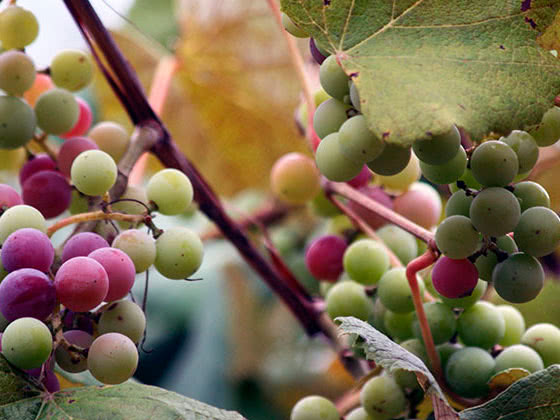

Autumn watering rules
After limited watering in late summer and harvesting, the shrubs need to be saturated with moisture. Watering should not be frequent and abundant, but it should be necessary.
Winegrower advice! If the ground is sandy, water needs to be poured often and not much. Clay soil needs abundant and rare moisture.
In mid-October (for the middle lane), but before the frost begins, you need to saturate the soil with moisture. The procedure will help create a frost-resistant root barrier. The more the soil is moistened, the less it is exposed to freezing.
Preparing grapes for winter
Preparing grapes for winter
If you do not know how to prepare grapes for winter, then follow our advice. In areas with cold winters, those grape varieties that painfully endure frosts are sheltered, especially if you do not snow every year in winter.
Before sheltering the grapes for the winter, it is treated for pests and diseases and pruned. From late October to mid-November, you need to prepare the grapes for shelter. Don't worry if the temperature drops to 7-8 ºC - grapes will only benefit from this hardening.Young plants are covered with earth for the winter, and if the frosts do not drop below -15 ºC, this will be enough, and in case of a stronger temperature drop, the seedling is covered with a wooden box covered with roofing felt.
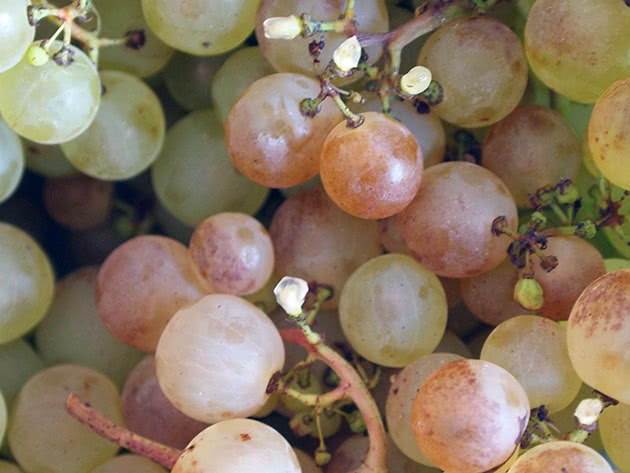

Protection against diseases and pests
Falling foliage does not protect the vine from pests. They climb under a dry crust on the vine, in the buds, and hide in the ground. In order not to transfer diseases and pests to the next season, it is important to process the bushes in the fall.
The first treatment can be carried out when the leaves have not yet fallen. The usual soda-salt solution is an affordable and effective method for treating fungi and pests. For 1 liter of water you need 1 tbsp. a spoonful of salt and 1 teaspoon of baking soda. Spray both foliage and vines. The procedure must be repeated 3-5 times throughout the fall from mid-September to mid-October.
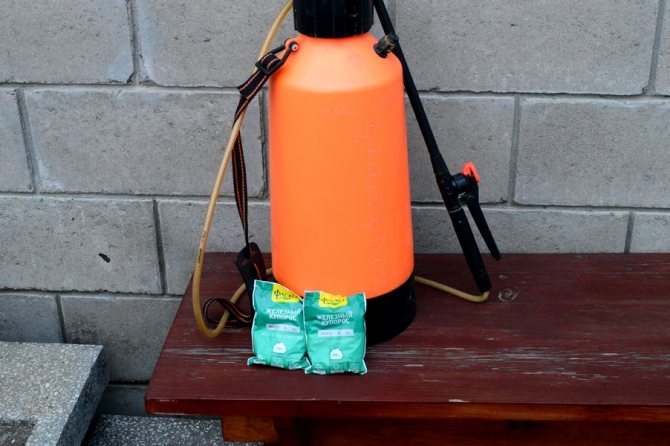

Plain lime can also help protect shrubs from disease and pests. It is necessary to take 1 kg of lime and extinguish it with 3 liters of water. After the reaction subsides, dilute the solution to 10 liters. The entire surface of the grapes is processed with a brush.
After pruning, the vine is treated with a solution of copper and iron sulfate. It is a protection against fungi. Iron sulfate is taken in an amount of 40 g per 1 liter of hot water, copper sulfate - 10 g per liter. Both the vine and the soil around the shrub should be cultivated.
It's important to know! Treatment for parasites and fungi should be carried out on dry days. The solution should dry and be absorbed into the plant.
The soil between shrubs and rows of grapes must be dug deeply. This kills the larvae of pests and prevents the spread of infections and fungi.


